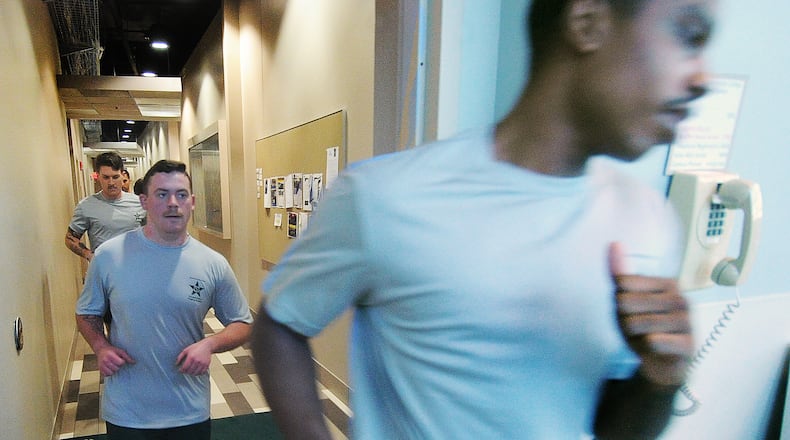The seven recommendations come from a task force assembled by Yost to “take a look at what we were doing and what we ought to be doing” and help the state become a national leader in academy training. The group included Dayton Police Department Assistant Chief Eric Henderson and Vandalia Police Chief Kurt Althouse.
Specifically, the group was tasked with updating the state’s minimum academy training curriculum — state rules laying out what Ohio’s licensed police academies must include in a mandated 740 hours of training. Yost believes these rules to be outdated.
Communication changes
In a press conference, Tom Quinlan, executive director of the Ohio Peace Officer Training Academy and chair of the task force, said the group aimed to direct academies to reduce focus on traditional law enforcement, but rather to transition into training of “police services.”
“It’s not just about enforcing laws anymore. Police are called on for so many tasks,” said Quinlan, who noted that communication skills run central to each and every task police are asked to handle “from the most mundane to the most critical, high stress situations.”
“We have many hours in a lot of other subjects. 70 hours, for instance, in subject control and 40 hours on radar, (we’ve had) zero hours on communication,” Quinlan said. “Specifically: How to talk with people, how to read body language, how to not escalate situations but de-escalate situations. Communication has become a real key piece that we found to be missing in the standard training for peace officers.”
Quinlan noted that the recommendations maintain the 740 hour minimum training the state requires but asked that the state reconfigure 72 of those hours, primarily to accommodate 48 hours of communication training. Subjects the group suggesting reducing hours on in order to accommodate this include radar training and a class on dealing with the mental and emotional toll of police work.
The group also recommended additional training on active threats and critical decision making.
In addition to the state’s minimum training requirements, individual academies such as Dayton’s Sinclair Criminal Justice Training Center, can add however much time on whatever topics they see fit. Many individual academies add hundreds of additional hours of their own curriculum.
Changes to physical fitness tests
The group also recommended adding some leniency in assessing a recruit’s physical conditioning.
Under current requirements, students must be able to complete a number of pushups and sit-ups and run a mile-and-a-half in a set amount of time by the end of training (benchmarks vary by age and gender). If a student fails to meet one of those benchmarks on two tests in a row, they have to restart the entire academy.
“In a time where it’s really hard to recruit and retain good quality officers, we find that we’re losing some people because of three or four seconds on a run, or one pushup or one sit-up,” Quinlan said.
The group’s recommended solution to this conundrum is to give some grace to recruits who pass two-out-of-three physical tests, as long as they came within 75% sufficiency in the third.
Changes to continued professional development
Quinlan also noted the need for the state to continue funding working officers’ continued professional development while tweaking the law.
Current law mandates officers receive 24 hours of continued training per year; eight of those hours must be in OPOTA-approved courses and 16 of those hours can be in courses directed by police agencies.
That training is only required if the state provides funding to local departments for it. The state’s current budget includes that funding, but there’s no guarantee it’ll be funded in the future.
Quinlan said some agencies have been sending their officers to courses that don’t line up with best practices and expressed that he’d like OPOTA to have more control over what courses agencies send their officers to, especially if the state is going to reimburse them for the costs associated with their absence.
Other proposals
The rest of the group’s recommendations include:
• Creating an additional 80-hour course to train officers on how to address chaotic or agitated events, particularly those that require a multiple-officer response;
• Using technology, such as virtual reality goggles, to create and implement “situational decision making” training courses;
• Tweaking working officers’ yearly firearms training to include decision-making training and written tests that cover local, state and federal laws regarding an officer’s weapon use and an officer’s duty to render aid.
The group’s recommendations are not legally binding. Yost told reporters that he believes some of the recommendations will be swiftly approved and enacted by the Ohio Peace Officer Training Commission within the coming weeks.
Other recommendations will have to be addressed in the legislature, which Yost said he hopes will be done by the end of this year.
Follow DDN statehouse reporter Avery Kreemer on X or reach out to him at Avery.Kreemer@coxinc.com or at 614-981-1422.
About the Author

